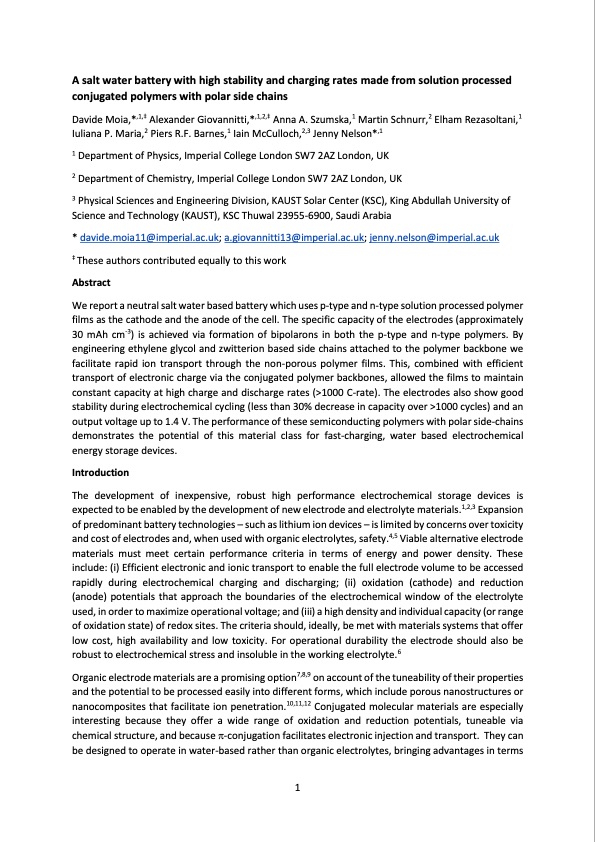
PDF Publication Title:
Text from PDF Page: 001
A salt water battery with high stability and charging rates made from solution processed conjugated polymers with polar side chains Davide Moia,*,1,‡ Alexander Giovannitti,*,1,2,‡ Anna A. Szumska,1 Martin Schnurr,2 Elham Rezasoltani,1 Iuliana P. Maria,2 Piers R.F. Barnes,1 Iain McCulloch,2,3 Jenny Nelson*,1 1 Department of Physics, Imperial College London SW7 2AZ London, UK 2 Department of Chemistry, Imperial College London SW7 2AZ London, UK 3 Physical Sciences and Engineering Division, KAUST Solar Center (KSC), King Abdullah University of Science and Technology (KAUST), KSC Thuwal 23955-6900, Saudi Arabia * davide.moia11@imperial.ac.uk; a.giovannitti13@imperial.ac.uk; jenny.nelson@imperial.ac.uk ‡ These authors contributed equally to this work Abstract We report a neutral salt water based battery which uses p-type and n-type solution processed polymer films as the cathode and the anode of the cell. The specific capacity of the electrodes (approximately 30 mAh cm-3) is achieved via formation of bipolarons in both the p-type and n-type polymers. By engineering ethylene glycol and zwitterion based side chains attached to the polymer backbone we facilitate rapid ion transport through the non-porous polymer films. This, combined with efficient transport of electronic charge via the conjugated polymer backbones, allowed the films to maintain constant capacity at high charge and discharge rates (>1000 C-rate). The electrodes also show good stability during electrochemical cycling (less than 30% decrease in capacity over >1000 cycles) and an output voltage up to 1.4 V. The performance of these semiconducting polymers with polar side-chains demonstrates the potential of this material class for fast-charging, water based electrochemical energy storage devices. Introduction The development of inexpensive, robust high performance electrochemical storage devices is expected to be enabled by the development of new electrode and electrolyte materials.1,2,3 Expansion of predominant battery technologies – such as lithium ion devices – is limited by concerns over toxicity and cost of electrodes and, when used with organic electrolytes, safety.4,5 Viable alternative electrode materials must meet certain performance criteria in terms of energy and power density. These include: (i) Efficient electronic and ionic transport to enable the full electrode volume to be accessed rapidly during electrochemical charging and discharging; (ii) oxidation (cathode) and reduction (anode) potentials that approach the boundaries of the electrochemical window of the electrolyte used, in order to maximize operational voltage; and (iii) a high density and individual capacity (or range of oxidation state) of redox sites. The criteria should, ideally, be met with materials systems that offer low cost, high availability and low toxicity. For operational durability the electrode should also be robust to electrochemical stress and insoluble in the working electrolyte.6 Organic electrode materials are a promising option7,8,9 on account of the tuneability of their properties and the potential to be processed easily into different forms, which include porous nanostructures or nanocomposites that facilitate ion penetration.10,11,12 Conjugated molecular materials are especially interesting because they offer a wide range of oxidation and reduction potentials, tuneable via chemical structure, and because -conjugation facilitates electronic injection and transport. They can be designed to operate in water-based rather than organic electrolytes, bringing advantages in terms 1PDF Image | salt water battery with high stability

PDF Search Title:
salt water battery with high stabilityOriginal File Name Searched:
salt-water-battery.pdfDIY PDF Search: Google It | Yahoo | Bing
Product and Development Focus for Salgenx
Redox Flow Battery Technology: With the advent of the new USA tax credits for producing and selling batteries ($35/kW) we are focussing on a simple flow battery using shipping containers as the modular electrolyte storage units with tax credits up to $140,000 per system. Our main focus is on the salt battery. This battery can be used for both thermal and electrical storage applications. We call it the Cogeneration Battery or Cogen Battery. One project is converting salt (brine) based water conditioners to simultaneously produce power. In addition, there are many opportunities to extract Lithium from brine (salt lakes, groundwater, and producer water).Salt water or brine are huge sources for lithium. Most of the worlds lithium is acquired from a brine source. It's even in seawater in a low concentration. Brine is also a byproduct of huge powerplants, which can now use that as an electrolyte and a huge flow battery (which allows storage at the source).We welcome any business and equipment inquiries, as well as licensing our flow battery manufacturing.| CONTACT TEL: 608-238-6001 Email: greg@salgenx.com | RSS | AMP |